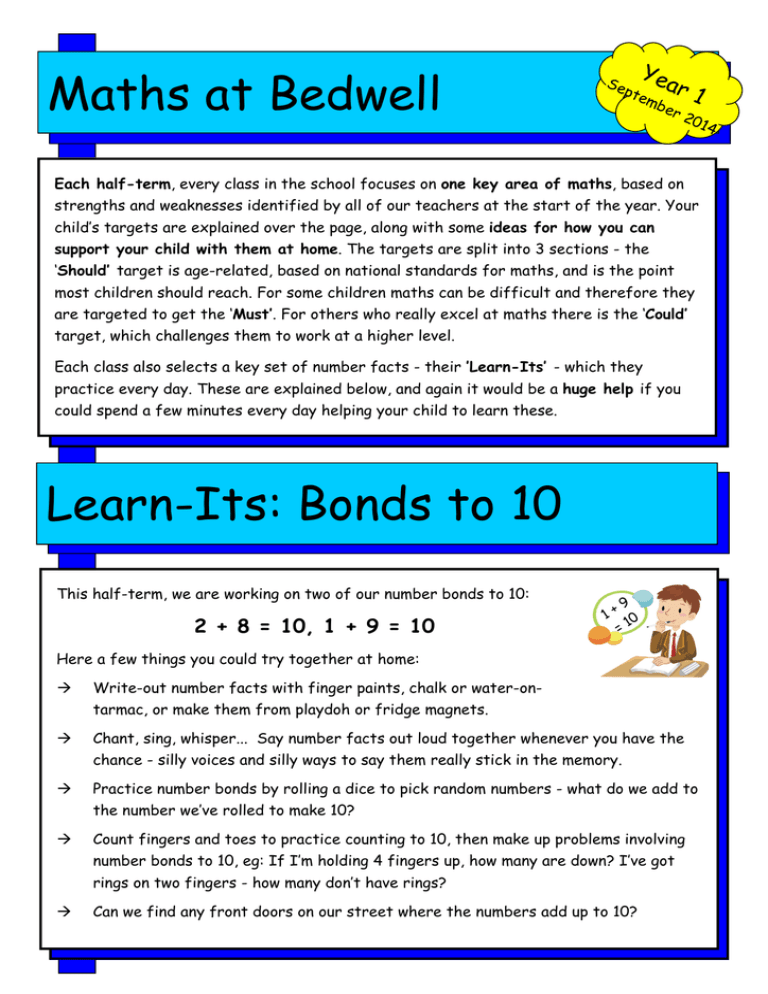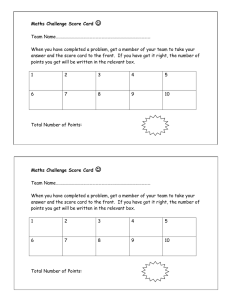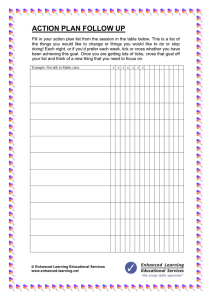Year 1 - autumn 1 target take home - counting
advertisement

Maths at Bedwell Se Ye ar pt em 1 be r2 0 14 Each half-term, every class in the school focuses on one key area of maths, based on strengths and weaknesses identified by all of our teachers at the start of the year. Your child’s targets are explained over the page, along with some ideas for how you can support your child with them at home. The targets are split into 3 sections - the ‘Should’ target is age-related, based on national standards for maths, and is the point most children should reach. For some children maths can be difficult and therefore they are targeted to get the ‘Must’. For others who really excel at maths there is the ‘Could’ target, which challenges them to work at a higher level. Each class also selects a key set of number facts - their ’Learn-Its’ - which they practice every day. These are explained below, and again it would be a huge help if you could spend a few minutes every day helping your child to learn these. Learn-Its: Bonds to 10 xx This half-term, we are working on two of our number bonds to 10: 2 + 8 = 10, 1 + 9 = 10 9 1+ 0 =1 Here a few things you could try together at home: Write-out number facts with finger paints, chalk or water-ontarmac, or make them from playdoh or fridge magnets. Chant, sing, whisper... Say number facts out loud together whenever you have the chance - silly voices and silly ways to say them really stick in the memory. Practice number bonds by rolling a dice to pick random numbers - what do we add to the number we’ve rolled to make 10? Count fingers and toes to practice counting to 10, then make up problems involving number bonds to 10, eg: If I’m holding 4 fingers up, how many are down? I’ve got rings on two fingers - how many don’t have rings? Can we find any front doors on our street where the numbers add up to 10? g& n i t n Cou ring e ord Maths Targets Introduction to concept of targets; Must Should Could I can recognise and order numbers to 20 I can recognise and order numbers beyond 20 I can write numbers to 20 I can write numbers beyond 20 Note on age related expectations I can use number names to count objects How you can help: Count anything and everything - houses on the way to School, footsteps on the way to bed, shoes in the house, players on the team, objects in the shopping trolley, claps, nods... It doesn’t matter what, just find opportunities to count as often as you can. Check that your child recognises that the last number you’ve said is the total number counted. Look for numbers in the natural environment - helping your child to understand that numbers are all around them and always have the same meaning (if I say I have 5 ‘things’, everyone else knows what that means, no matter what the ‘thing’ is). Put a pack of cards into order, recognising and ordering numbers, and linking these to the number of hearts / clubs etc pictured on the card. Practice writing numbers in sand, salt or water, or try making numbers out of groups of pebbles. Help your child to make sure their numbers are the right way round, too - it’s much easier to address this now while they’re still learning patterns, shapes and hand movements, rather than later when ideas are ’fixed’ This target is all about matching objects to a number, so practice counting out specific numbers - can you make a group of 7 teddies? What can you make from just 14 bits of Lego? Can you pair-up 16 socks while we sort the laundry? Make number trains: to practice counting: 1 2 3 4

